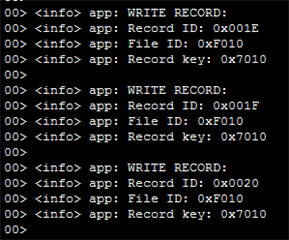nrf52832 S132 v6.1.1
i want to write saadc data in flash, so i call "write_to_flash" function in "void saadc_callback(nrf_drv_saadc_evt_t const * p_event)"
void saadc_callback(nrf_drv_saadc_evt_t const * p_event)
{
int product;
uint16_t val;
uint8_t value;
ret_code_t err_code;
product = channel3_enabled*8 + channel2_enabled*4 + channel1_enabled*2 + channel0_enabled;
if (p_event->type == NRF_DRV_SAADC_EVT_DONE)
{
static uint8_t data_array[SAMPLES_IN_BUFFER*2];
err_code = nrf_drv_saadc_buffer_convert(p_event->data.done.p_buffer, SAMPLES_IN_BUFFER);
APP_ERROR_CHECK(err_code);
uint8_t i;
printf("\r\nADC event number:%d \r\n", (int)m_adc_evt_counter);
for (i = 0; i < SAMPLES_IN_BUFFER; i++)
{
data_array2[i]=p_event->data.done.p_buffer[i];
val = p_event->data.done.p_buffer[i];
printf("%d\r\n",val);
//8MSB data
value=val>>4;//right shift 4 bit
value |= 1;//XXXX_XXX1,1 means MSB
value &= 247;//XXXX_0XX1,0 means saadc data
value = dataencode(i, product, value);
data_array[(i*2)]=value;
value=0;
//8LSB data,XXXX_XXX0
value=val;
value&=254;
data_array[i*2+1]=value;
value=0;
}
uint16_t length = (uint16_t)(i*2);
memcpy(data_array3,data_array,length);
if(!writeflash_en)
{err_code = ble_nus_data_send(&m_nus, data_array, &length, m_conn_handle);}
else
{write_to_flash();}
if ( (err_code != NRF_ERROR_INVALID_STATE) && (err_code != NRF_ERROR_BUSY) && (err_code != NRF_ERROR_NOT_FOUND) )
{
APP_ERROR_CHECK(err_code);
}
m_adc_evt_counter++;
}
}
void write_to_flash(void)
{
fds_record_desc_t desc = {0};
ret_code_t rc;
rc = fds_record_write(&desc, &m_dummy_record);
if(rc == FDS_ERR_NO_SPACE_IN_FLASH)
{
stop_saadc();
writeflash_en = 0;
ret_code_t err_code;
uint16_t length;
length = 2;
uint8_t flash_full[2];
flash_full[0] = 105;
flash_full[1] = 105;
err_code = ble_nus_data_send(&m_nus, flash_full, &length, m_conn_handle);
if ( (err_code != NRF_ERROR_INVALID_STATE) && (err_code != NRF_ERROR_BUSY) && (err_code != NRF_ERROR_NOT_FOUND) )
{
APP_ERROR_CHECK(err_code);
}
NRF_LOG_INFO("NO SPACE IN FLASH, FDS OPERATION WILL BE OVER")
}
if( rc== FDS_ERR_NO_SPACE_IN_QUEUES)
{
writeflash_en = 0;
stop_saadc();
NRF_LOG_INFO("NO SPACE IN QUEUES, FDS OPERATION WILL BE OVER");
}
}
sizeof(data_array3) is 240, so every record in flash is 60 words,
virtual page is 3;
virtual page size 1024;
then i stop adc and read data when flash is full, i get 32 records ,every record only contains 16 or 19 or ......words ,less than 60 words.
if everythng is correct, i can get 32 records and 60 words in every record;
the following is my read_from_flash() function
void read_from_flash()
{
//±£´æÃØÔ¿µÄÁîÅÆÇåÁã
fds_find_token_t tok = {0};
ret_code_t rc;
rc = fds_record_find(CONFIG_FILE, CONFIG_REC_KEY, &desc, &tok);//¶ÔÓ¦KEY¼Ç¼²éÕÒÊý¾Ý
NRF_LOG_INFO("record_id:%8x",desc.record_id);
NRF_LOG_INFO("p_record:%8x",desc.p_record);
if (rc == FDS_SUCCESS)
{
/* A config file is in flash. Let's update it. */
fds_flash_record_t config = {0};
/* Open the record and read its contents. */
rc = fds_record_open(&desc, &config);
APP_ERROR_CHECK(rc);
NRF_LOG_INFO("Found Record ID = %d",desc.record_id);
NRF_LOG_INFO("Data = ");
data = (uint32_t *)config.p_data;
static uint8_t data_array_send[4];
for (uint16_t i=0; i<config.p_header->length_words; i++)//i<config.p_header->length_words(60)
{
NRF_LOG_INFO("0x%8x",data[i]);
data_array_send[0] = data[i];
data_array_send[1] = data[i]>>8;
data_array_send[2] = data[i]>>16;
data_array_send[3] = data[i]>>24;
uint16_t length1= 4;
ble_nus_data_send(&m_nus, data_array_send, &length1, m_conn_handle);
}
NRF_LOG_INFO("\r\n");
/* Close the record when done reading. */
while(fds_record_close(&desc) != FDS_SUCCESS)
{NRF_LOG_INFO("flash close fail");}
while(fds_record_delete(&desc) != FDS_SUCCESS)
{NRF_LOG_INFO("flash delete fail")}
}
else
{
NRF_LOG_INFO("can't find record or no more record to be read");
while(app_timer_stop(m_timer_id) != NRF_SUCCESS)
{NRF_LOG_INFO("stop timer fail");}
rc = fds_gc();
if(rc == FDS_SUCCESS)
{
NRF_LOG_INFO("GC SUCCESS");
uint16_t length;
length = 2;
uint8_t flash_read_end[2];
flash_read_end[0] = 121;
flash_read_end[1] = 121;
ble_nus_data_send(&m_nus, flash_read_end, &length, m_conn_handle);
}
stat();
}
}
it's called by a timer.
so what's the problem about "read data less than written data" ?
Any suggestion will be appreciated.

